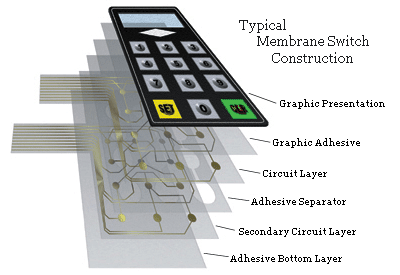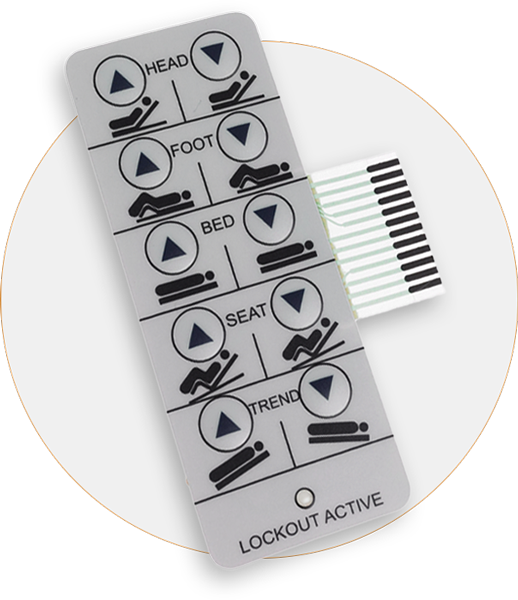The Role of Membrane Switches in Enhancing Product Aesthetics
Wiki Article
Discover Exactly How Membrane Switches Function and Their Function in Modern Electronic Devices
Membrane Switches stand for a sophisticated integration of modern technology and style within the world of modern electronics, offering as vital user interfaces in countless devices. Understanding the details of Membrane button capability and their wider implications in improving individual experience invites further expedition right into their layout, benefits, and the ingenious developments forming their future in modern technology.
What Are Membrane Switches?

Membrane switches are differentiated by their sturdiness and resistance to ecological variables, such as dust, moisture, and extreme temperatures. They can be personalized with numerous graphics, shades, and responsive responses alternatives, enhancing user experience while maintaining visual charm - membrane switches. The consolidation of published circuits enables for seamless combination right into tools, boosting total capability.
The versatility of Membrane switches appears in their capacity to sustain both simple and complicated control functions. They can include features such as LED signs and touch-sensitive modern technology, catering to specific individual requirements. As innovation remains to advance, Membrane Switches continue to be important for making it possible for intuitive and efficient individual interfaces, thus playing a pivotal function in the advancement of contemporary digital gadgets.
Elements of Membrane Buttons
Membrane switches are made up of numerous essential components that work together to create a dependable and useful interface. The primary elements consist of the visuals overlay, sticky layer, spacer layer, and conductive traces.The graphic overlay functions as the customer interface, typically printed on an adaptable substrate such as polyester or polycarbonate. This layer not just provides aesthetic appeal but also includes tactile feedback, aesthetic signs, and protective features. Below the graphic overlay lies the sticky layer, which protects the button to the gadget and ensures durability against ecological stresses.
The spacer layer is critical for preserving the necessary space in between the graphic overlay and the circuit layer. This space enables the activation of the switch when pressure is applied. The conductive traces, usually made from silver or carbon, form the electrical paths that finish the circuit when the button is involved.
Furthermore, a support layer may be included for architectural support and insulation. These elements team up perfectly, making sure that Membrane switches are both easy to use and resilient, making them crucial in different modern-day digital applications.
Just How Membrane Switches Work
How do Membrane Switches feature successfully within electronic gadgets? Membrane Switches operate on the principles of pressure-sensitive modern technology, making use of a split building that includes graphic overlays, sticky layers, and conductive components. When a customer applies pressure to the switch, the top layer warps, allowing the conductive components beneath to make call and finish an electric circuit. This activity activates the preferred function within the tool.The design of Membrane switches is essential for their efficient procedure (membrane switches). The layers are carefully engineered to offer tactile feedback, sturdiness, and resistance to ecological variables such as wetness and dirt. The inclusion of domes-- little, increased areas within the button-- enhances responsive response, supplying individuals with a visible click experience upon activation
Furthermore, Membrane switches can be personalized in terms of size, form, and graphics, making them appropriate for various applications. They are usually made use of in control panels, medical tools, and customer electronics due to their streamlined style and integrity. In general, the effective performance of Membrane buttons is pivotal in improving user communication and making certain seamless procedure in modern-day digital gadgets.

Applications in Modern Devices
Using their unique layout and performance, Membrane switches have come to be essential components in a vast array of modern electronic devices. These functional interfaces are utilized in customer electronics, commercial devices, medical devices, and auto controls, supplying seamless individual interaction.In customer electronic devices, Membrane switches are commonly found in devices like microwaves, washing devices, and other home devices, where they enable instinctive control with a streamlined account. Their low-profile design helps with integration right into compact devices, boosting aesthetic allure without compromising functionality.
In commercial applications, Membrane Switches act as control board for equipment, using longevity and resistance to severe environments. Their capacity to hold up against wetness and pollutants makes them ideal for usage in manufacturing and handling sectors.
Clinical tools also benefit from Membrane switches, which are created to be easy to tidy and keep, ensuring health in medical settings. They are typically utilized in diagnostic equipment, patient tracking systems, and portable clinical tools, where integrity is paramount.
Advantages of Membrane Buttons
One of the crucial benefits of Membrane buttons is their adaptability, which allows them to be tailored for a variety of applications across several markets. These buttons can be created in different sizes and shapes, fitting one-of-a-kind product visit requirements while providing smooth assimilation right into devices. Their thin account allows a compact and sleek layout, commonly enhancing the visual allure of electronic products.One more significant advantage is their longevity - membrane switches. Membrane switches are normally resistant to dust, wetness, and chemicals, making them optimal for extreme atmospheres. This durability extends their life-span compared to traditional mechanical buttons, reducing the need for frequent replacements
Furthermore, Membrane Switches offer cost-effectiveness. The manufacturing procedure entails printing technologies that decrease manufacturing costs, particularly for big runs. This affordability, incorporated with low maintenance demands, makes them an attractive alternative for Bonuses makers.

Verdict
In verdict, Membrane Switches represent a substantial improvement in individual interface technology within modern electronic devices. As the need for resistant and instinctive interfaces continues to grow, the duty of Membrane buttons in shaping user experience will definitely expand.Membrane Switches stand for an advanced integration of modern technology and style within the world of contemporary electronics, offering as necessary user interfaces in many devices.In the world of modern electronic devices, Membrane Switches offer as essential elements that facilitate individual interaction with gadgets. As technology continues to advance, Membrane Switches continue to be vital for allowing user-friendly and reliable user interfaces, consequently playing a critical role in the innovation of contemporary digital tools.
Exactly Resources how do Membrane Switches function successfully within electronic tools? In general, the reliable performance of Membrane switches is essential in enhancing user interaction and making certain seamless operation in contemporary electronic tools.
Report this wiki page